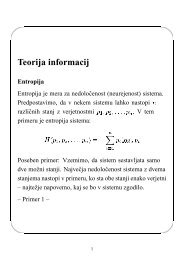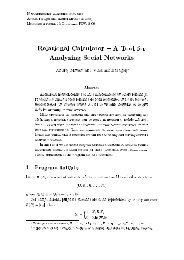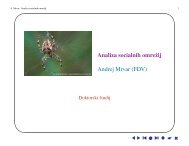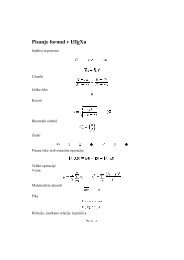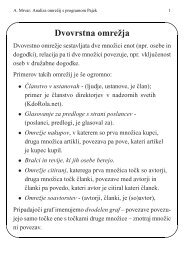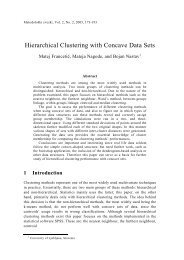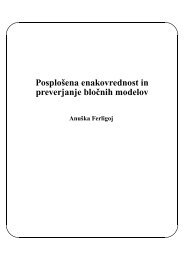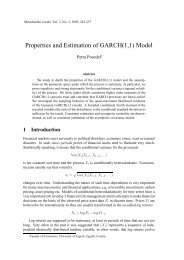Computing Regular Equivalence: Practical and ... - CiteSeerX
Computing Regular Equivalence: Practical and ... - CiteSeerX
Computing Regular Equivalence: Practical and ... - CiteSeerX
Create successful ePaper yourself
Turn your PDF publications into a flip-book with our unique Google optimized e-Paper software.
171 Front Street West in Toronto is another good example of the need to collaborate. As a Class A developmentopportunity, it’s not something that falls squarely within our sphere of competence, so we’ve evaluated potentialcollaborators with proven expertise in developing Class A office buildings with a view to entering into a 50/50joint venture to execute on the opportunity. We expect to finalize this process by year-end.Some value-creation opportunities are best pursued on our own. Our solo activity has also accelerated thisyear, with the addition of a large upgrade opportunity in Montréal, the acquisition of a redevelopment projectin Calgary <strong>and</strong> the advancement of four urban intensification opportunities in Toronto, including the pendinglaunch of full construction at QRC West.We also established a new <strong>and</strong> promising avenue of growth earlier this year, the expansion of our telcom <strong>and</strong>IT facilities through the long-term lease of space at 250 Front Street West in Toronto. We own approximately340,000 square feet of specialized space for telcom <strong>and</strong> IT tenants, all of which is leased or in the final stages ofnegotiation. The facility at 250 Front will have similar attributes once we complete a $30 million upgrade nextyear, at which time we’ll lease it to telcom <strong>and</strong> IT tenants on financial terms similar to those achievable at 151Front. We expect the facility to be very accretive to our annual AFFO per unit from 2014 onward.outlookWe expect our FFO <strong>and</strong> AFFO per unit to continue to grow over the remainder of the year, <strong>and</strong> we expect thedem<strong>and</strong> for space across our target markets to remain strong. Looking forward, we’re determined to broaden <strong>and</strong>deepen our urban office platform through continued consolidation of ownership in our target markets. We’realso determined to build a value-creation pipeline that in time will make a recurring, annual contribution tothe growth of our business. We believe that our conservative balance sheet, low debt ratio, moderate mortgagematurity schedule <strong>and</strong> abundant liquidity will provide stability <strong>and</strong> facilitate growth going forward. All of this ispart of our ongoing effort to establish the basis for above-average FFO <strong>and</strong> AFFO per unit growth in the comingyears.We’ll keep you apprised of our progress. In the meantime, if you have any questions or comments, please don’thesitate to call me at (416) 977-0643 or e-mail me at memory@alliedreit.com.Yours truly,Michael R. Emorypresident <strong>and</strong> chief executive officer
<strong>Computing</strong> <strong>Regular</strong> <strong>Equivalence</strong>: <strong>Practical</strong> <strong>and</strong> Theoretical Issues 39profile (1) = (0,1,1,1,2,3,4,5,4,5)profile (3) = (1,1,0,2,1,2,3,3,4,4)profile (7) = (4,4,3,3,2,1,0,2,1,1)If we now arrange the elements in ascending order we obtain the followingprofile ′(1) = (0,1,1,1,2,3,4,4,5,5)profile ′(3) = (0,1,1,1,2,2,3,3,4,4)profile ′(7) = (0,1,1,1,2,2,3,3,4,4)We immediately see that 3 <strong>and</strong> 7 are identical <strong>and</strong> that 1 is different. We canprovide a measure of all pairs by taking reciprocals before comparing profiles.An alternative methods has been proposed by Sparrow (1993) using numericalsignatures. This is a neat method <strong>and</strong> is based upon extending the idea of degreesequences of neighbourhoods. Suppose a vertex j is adjacent to a set of nodeswhich have degrees 1,1,1,4 <strong>and</strong> 7. We then combine these into a unique numberwhich is independent of any permutation of the vertices. We form S j,1 (1 + π)(1 +π) (1 + π) (4 + π) (7 + π)The use of the transcendental number π means that S j,i can only be formedfrom 1,1,1,4 <strong>and</strong> 7. This is then iterated so that S j, k + 1 = Π (π + S j,k )This iteration means that the degree sequence of the higher orderneighbourhoods are taken into account. Finally we need to modify S so that it cantake account of different cycle lengths. We use a different transcendental number(e in this case) so that our uniqueness property is preserved.S j,k+1 = (⎮N k+1 (j)⎮+ e) Π (Π + S j,k ).This unique (theoretically it need not be unique since the iterative nature of theconstruction means that it is possible to produce the same number from a differentgraph) can then be used to partition the graph. Unfortunately the signaturesthemselves do not have any meaning – but this could be a fruitful line of research.5.4 Combinational optimisationAn alternative approach is to specify the number of colours in advance <strong>and</strong> findcoloration which is nearly regular. The cost of a coloration is the minimumnumber of edge changes (deletion or addition) required to make the colorationregular. The cost of a regular coloration is therefore zero. Once a cost has beenestablished then we can use st<strong>and</strong>ard combinational optimisation techniques tofind the coloration which has the lowest cost. Batagelj et al. (1992) first suggestedthis approach <strong>and</strong> they use local search. Others here used genetic algorithms,simulated annealing or tabu search.
40 Martin Everett <strong>and</strong> Steve Borgatti6 Algorithmic complexityWe have already mentioned the complexity of finding the automorphicallyequivalent vertices. We also gave a polynomial time algorithm for finding themaximal regular coloration <strong>and</strong> we noted that it is easy to find structurallyequivalent vertices. The use of combinatorial optimisation routines to findcolorations with a specified number of colours suggests that these are non-trivialproblems.We now look at the complexity of finding if a regular coloration exists with aspecified number of colours. We shall suppose that our graphs or digraphs have nvertices. The image graph of a coloration is a graph (or digraph) with colours asvertices <strong>and</strong> an edge connects colour A to colour B if there is an edge joining avertex coloured A to a vertex coloured B in the original graph.Suppose we wish to check for n-colours. Since this is always a regularcoloration then there is nothing to do <strong>and</strong> the problem is in the class P. It is alsoeasy to check for n-1 colours. In this case the pair of vertices coloured the samemust be connected to <strong>and</strong> from the same vertices (that is they are structurallyequivalent) <strong>and</strong> hence this belongs to the class P.At the other extreme suppose we wish to use just one colour. Clearly this mustbe in the class P since we simply colour all the vertices <strong>and</strong> check it is regular.However as in the n-1 case we can characterise the graphs <strong>and</strong> digraph which havea 1-regular coloration. For a graph to have a 1–regular coloration it is either thenull graph or is a graph with no isolates.For a digraph it is either the null graph or it has no sources, sinks or isolates.The simplest interesting case is a 2-regular coloration <strong>and</strong> this was investigatedfor graphs by Roberts <strong>and</strong> Sheng (1999). They show that finding a 2-regularcoloration for a graph belongs to the class NP. It follows that for digraphs theproblem cannot be in P <strong>and</strong> almost certainly belongs to the class NP as well. Inaddition they show that for certain image graphs we can characterise 2-regularcolorations. These are as follows. If G was the original graph then the followingimage graphs are possible:R 1 R 2R 3 R 4• R 1 is possible iff G is a null graph• R 2 is possible iff G has at least one edge <strong>and</strong> at least one isolated vertex• R 3 is possible iff G is disconnected with no isolates• R 4 is possible iff G is bipartite with no isolates.
<strong>Computing</strong> <strong>Regular</strong> <strong>Equivalence</strong>: <strong>Practical</strong> <strong>and</strong> Theoretical Issues 41The problem of determining whether the two remaining images are possibleboth belong to the class NP.We can similarly characterise 7 of the 10 possible digraph images. These areas follows where D was the original digraph.R 1 R 2R 3 R 4R 5 R 6R 7• R 1 is possible iff D is a null graph.• R 2 is possible iff D has isolates but no sources or sinks.• R 3 is possible iff D is disconnected with no sources, sinks or isolates.• R 4 is possible iff D has no isolates <strong>and</strong> every vertex is a source or sink.• R 5 is possible iff D has no sources, sinks or isolates <strong>and</strong> the underlying graph isbipartite.• R 6 is possible iff D has no isolates or sinks but contains at least one source.• R 7 is possible iff D has no isolates or sources but contains at least one sink.• We conjecture that the 3 remaining images give rise to problems which aremembers of the class NP.References[1] Batagelj, V., Doreian, P., <strong>and</strong> Ferligoj, A. (1992): An optimisation approachto regular equivalence. Social Networks, 14, 121-135.[2] Borgatti, S. <strong>and</strong> Everett, M. (1989): The class of all regular equivalences:Algebraic structure <strong>and</strong> computation. Social Networks, 11, 65-88.[3] Borgatti, S., Everett M., <strong>and</strong> Freeman, L. (1999): UCINET V: Software forSocial Network Analysis. Natick: Analytic Technologies.[4] Burt, R. (1976): Positions in networks. Social Forces, 55, 93-122.[5] Everett, M. (1985): Role similarity <strong>and</strong> complexity in social networks. SocialNetworks, 7, 353-359.[6] Everett, M. <strong>and</strong> Borgatti, S. (1990): Role colouring a graph. MathematicalSocial Science, 21, 183-188.
42 Martin Everett <strong>and</strong> Steve Borgatti[7] Everett, M. <strong>and</strong> Borgatti, S. (1997): The regular colouration of graphs. In C.Mitchell (Ed.): Applications of Combinatorial Mathematics. OxfordClarendon Press.[8] Lorrain, F. <strong>and</strong> White, H. (1971): Structural equivalence of individuals innetworks. Journal of Mathematical Sociology, 1, 49-80.[9] Roberts, F. <strong>and</strong> Sheng, L. (1999): Role assignments. In Y. Alavi, P. Lick,<strong>and</strong> A. Schwenk (Eds): Combinatorries, Graph Theory <strong>and</strong> Algorithms. II,New Issues Press Kalamazoo, MI[10] Sparrow, M. (1991): A linear algorithm for computing automorphicequivalence classes: The numerical signatures approach. Social Networks,15, 151-170.[11] White, D. <strong>and</strong> White, H. (1983): Graph <strong>and</strong> semigroup homomorphisms onnetworks of relations. Social Networks, 5, 193-235.[12] Winship, C, <strong>and</strong> M<strong>and</strong>el, M. (1983): Roles <strong>and</strong> positions: A critique <strong>and</strong>extension of the block modelling approach. In S. Leinhardt (Ed.):Sociological Methodology, 1983-1984. San Francisco: Josey-Bass.[13] Wasserman, S. <strong>and</strong> Faust, K. (1994): Social Network Analysis – Methods <strong>and</strong>Applications. Cambridge, Engl<strong>and</strong>: Cambridge University Press.




